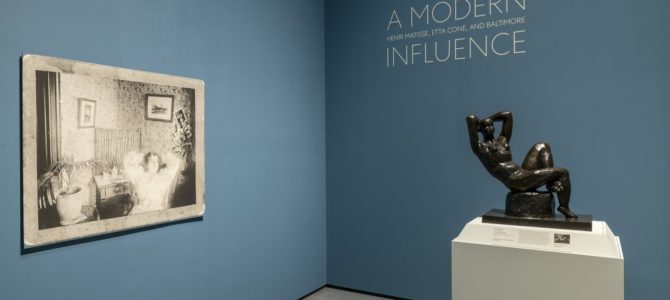
As more museums return to hosting major exhibitions, your commentator finds himself in the unenviable position of having more art to see than he has free time to do so. Fortunately, in a pair of shows now at the Baltimore Museum of Art, the art in question is located in galleries that are right next door to each other.
Matisse in Charm City
The long career of Henri Matisse (1869-1954), like that of his frenemy Pablo Picasso (1881-1973), produced works of great diversity in style, technique, and materials. Those seeking a reasonably comprehensive introduction to the output of one of the most popular of Modern artists then, would be well-advised to visit “A Modern Influence: Henri Matisse, Etta Cone, and Baltimore.” This is a big show, and visitors have a remarkable local woman to thank for the objects in it.
Collector and socialite Etta Cone (1870-1949) was born in Tennessee to German immigrant parents, and moved to Baltimore as a child. In her early 30s, she spent time traveling in Europe, where she naturally fell in with other Americans of means.

Among these was author and art collector Gertrude Stein (1874-1946), whom Cone had befriended years earlier while Stein was studying at Johns Hopkins. Through these connections Cone was introduced to cutting-edge contemporary artists such as Picasso and, perhaps most importantly, Henri Matisse. Over the next four decades, Cone acquired an enormous quantity of Matisse’s work: paintings, bronzes, drawings, even the engraved copper plates that Matisse used for his prints, all found their way into her hands.
Following the death of her sister, who was also an avid collector of Modern art, Cone inherited her collection. The bequest came with the proviso that “in the event the spirit of appreciation for modern art becomes improved in Baltimore,” the sisters’ works ought to eventually end up at the BMA. This provided Cone a goal beyond simple accumulation, causing her to redouble her efforts not only in acquiring works by her beloved Matisse, but also objects by a wide range of artists, including Picasso, Paul Cézanne (1839-1906), and Vincent van Gogh (1853-1890).
Given the longstanding friendship between artist and patron, and the realization that a significant amount of his art would eventually end up in an American museum, Matisse decided to visit Baltimore in 1930. At a party held in Cone’s apartment, Matisse would have seen his painting “Large Cliff with Fish” (1920), painted a decade earlier, hanging in the dining room.
As the accompanying exhibition placard indicates, family lore is that Cone was at first reluctant to acquire the piece because of concern about the pit of fish and other squirming sea creatures featured on the seashore. She was reassured, however, upon being informed that Matisse kept them hydrated while they “posed.” Nearby is a tableau featuring Matisse’s later “Odalisque, Left Knee Bent, Ornamental Background and Checkerboard” (1928), displayed above Cone’s drop-front antique Spanish desk, as Matisse himself would have seen it.

This seemingly non-linear arrangement is important because, unusually, the BMA show is not laid out in order of execution. Instead, Cone’s Matisses are arranged in order of acquisition, so the dates of the works in the exhibition jump backwards and forwards in time as you make your way through the galleries. It gives the visitor a real sense of how Cone’s appreciation for Matisse evolved with her tastes, while also showing how persistence can be of critical importance in collecting.
Near the beginning of the show, “Yellow Pottery from Provence” (1905) was the first painting by Matisse that Cone acquired, shortly after meeting the artist in Paris in January 1906. Its bright colors and wavy brushstrokes are a hallmark of Matisse’s Fauvist period. Although definitely not a traditional still life, given its unfinished appearance and melting colors, the piece is still a kind of “safe” work of Modern art: new and fashionable, but not too daring or large for a neophyte collector.

By contrast, it took Cone decades to persuade Matisse’s son Pierre to sell her the magnificent “Ballet Dancer Seated on a Stool” (1927), done in a kind of Mediterranean-Neo-Expressionist style (my apologies that art commentary is often a portmanteau). This canvas was painted long after Matisse had abandoned both Fauvism and Paris for the intense light of the French Riviera. Even though this piece dates earlier than the famous “Jazz” cut-outs of the 1940s displayed nearby, this penultimate work in the show ended up being one of the last Matisses that Cone acquired in 1949, the year of her death.

While Matisse’s art is undoubtedly what attracts the visitor’s attention in this show, it’s Cone’s connoisseurship and patronage that, in some ways, are conceptually the most interesting elements here. Putting aside the moments of wokeness and over-sharing in the accompanying texts, which pollute most museum exhibitions at present, the exhibition brings home the two-pronged rule that is perhaps the most helpful guide to the acquisition of art: buy what you like, and buy the best you can afford.
While most of us are never going to accumulate an art collection containing thousands of objects and estimated to be worth well more than $1 billion, Cone’s example is one of ongoing education, risk-taking, and taking the time to really get to know her subject area, a formula that can inspire any would-be collector.
Anything But Gris?
After exiting the Matisse show, one can immediately turn the corner and proceed into “Color and Illusion: The Still Lifes of Juan Gris,” which proved the more personally challenging of the two BMA exhibitions. Gris is an artist I’ve long been aware of, but whose work I’ve mostly ignored. Both the color and the illusion promised in the show’s title, however, in this selection of paintings drawn from American and international collections, proved to be far more compelling than anticipated.
José Victoriano González-Pérez (1887-1927) was born and raised in Madrid and moved to France at the age of 19. “Juan Gris,” or “John Grey,” as he later renamed himself, began his academic career in Spain studying engineering, before switching to art.
His earlier technical and mathematical background is helpful to know when looking at his art, in that it illuminates certain very precise aspects of how Gris later approached the composition of his paintings. One wonders what he might have done, whether as an engineer or as an artist, had programs like AutoCAD existed in his day.
Gris’s work as an illustrator and caricaturist for avant-garde publications gradually gave him access to unconventional thinkers, but as he became more interested in painting, his desire to be a part of what was new and different in the art world meant leaving early 20th century Madrid was inevitable. After relocating to France, he associated with the cultural elite who had made Paris an innovative crucible for artists, dealers, and their patrons. Among others, Matisse became a lifelong friend of the younger artist, as did fellow Spanish expatriate Picasso, who (as is usually the case with Picasso) both inspired and intellectually stole from his countryman.
Whereas the layout of the BMA’s Matisse exhibition proceeds in the order in which the works entered Cone’s collection, the Gris exhibition more conventionally follows the timeline of the artist’s life. We begin with a series of early, silvery gray pictures, such as “Jar, Bottle, and Glass” (1911) and “Still Life with Flowers” (1912), that almost anticipate the Art Deco movement and its love of elements such as polished surfaces and engine turning.

Yet while his fellow Cubists Picasso and Georges Braque (1882-1963) stuck to more monochromatic palettes and increasingly abstract forms in their explorations of this emerging style, Gris gradually came to employ not only a more intense use of color in his work, but also to look to the past for inspiration.
In “Still Life with Checked Tablecloth” (1915) for example, a rich bottle green sounds the dominant color note. Greens similarly dominate the supporting ochres, browns, and blacks of “The Coffee Mill” (1916).
By contrast, in both the unusually oval-shaped canvas “Fruit Dish and Bottle” (1916), and even more prominently in “Newspaper and Fruit Dish” (1916), an almost Moroccan blue glows like the sky in a Medieval manuscript illustration. Perhaps coincidentally, this electric color is what the Catalan Modernist artist Santiago Rusiñol (1861-1931) painted the main living space in his magnificent beach house-studio in the resort town of Sitges, south of Barcelona. As both artists exhibited at the same Barcelona gallery, and had many of the same friends in Paris, I wondered whether Gris had seen, or heard about, the extraordinary blue walls at Rusiñol’s retreat.

Toward the end of his life, Gris’s palette changed again, this time to more pastel and muted hues. Soft pinks and greens predominate the view of the “Open Window with Hills” (1923), while a muted cornflower blue is the color highlight of “Le Canigou” (1921), with its guitar set in front of a view of the Pyrenees. The more fractured and fragmented aspects of his work from a decade earlier had also by this point settled into something that looks less like an explosion, and more like a balance of planar surfaces.

This later style of what came to be known as “Crystal Cubism” stemmed from Gris’s close analysis of the construction of Old Master compositions, perhaps not dissimilarly from how he would have approached an engineering challenge earlier in his career. He would acquire postcard reproductions of works by great painters of the past, such as Francisco de Zurbarán (1598-1664) and Jean-Auguste-Dominique Ingres (1780-1867), break them into interlocking geometric shapes, then reassemble them in abstract yet recognizable ways. These studies would then inform the way he approached his own, original compositions.
I stated earlier that I found the Gris show was personally challenging. That’s because, thanks to my previously dismissive views of his work, the BMA show rather embarrassingly brought home just how wrong I can be.
As the exhibition title suggests, this isn’t just a display of an early type of abstraction in 20th-century art, but a visual celebration of the rich colors and harmonizing tones Gris employed throughout his brief career. It’s also, somewhat unexpectedly, an example of how the art of the past can be successfully examined and reimagined by an artist working many centuries later, and in a completely different style to boot.
This doesn’t mean that I’ve come to see Gris’s output as superior to what came before it. What it does mean, however, is that reconsidering long-held assumptions can sometimes produce significant results. In this case, that includes a deeper understanding of and appreciation for Gris’s art.
“A Modern Influence: Henri Matisse, Etta Cone, and Baltimore” at the Baltimore Museum of Art runs through January 2, 2022. “Color and Illusion: The Still Lifes of Juan Gris” continues until January 9, 2022. For more information, visit the museum’s website, and be advised that although the Gris show and the BMA’s permanent collection are free entry, the Matisse exhibition is a ticketed show. If you can’t make it to either, splendidly illustrated catalogs of both exhibitions are available through the BMA’s online shop.









